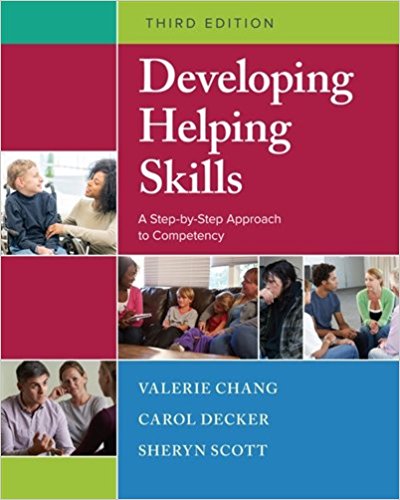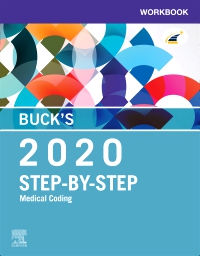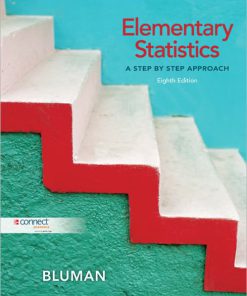Test bank for Developing Helping Skills: A Step-by-Step Approach to Competency 3rd Edition by Chang
$55.00 Original price was: $55.00.$29.99Current price is: $29.99.
Test bank for Developing Helping Skills: A Step-by-Step Approach to Competency 3rd Edition by Chang
This is completed downloadable of Test bank for Developing Helping Skills: A Step-by-Step Approach to Competency 3rd Edition by Chang

Product Details:
- ISBN-10 : 1305943260
- ISBN-13 : 978-1305943261
- Author: Valerie Nash Chang (Author), Carol L. Decker (Author), Sheryn T. Scott (Author)
Whether you are preparing for social work, psychology, counseling, marriage and family therapy, pastoral counseling, human services, or a related helping profession, this book presents the fundamental knowledge and skills you need. The authors’ multilayered learning system integrates reading and discussion with self-assessment and practice. DEVELOPING HELPING SKILLS prepares professionals in training for generalist practice with individuals, families, and groups, including entire communities and organizations. The text also includes a case that helps you learn to think like a professional. Finally, role playing in practice interviews as well as evaluation tools allow you to assess your progress and determine your readiness to apply your skills in real-life settings. If you use the MindTap online learning experience, you’ll have access to videos demonstrating application of the skills, flashcards, notetaking, a mobile app, and other resources to help you succeed in the course.
Table of Content:
- Section 1: Foundation
- Chapter 1: Understanding Yourself and Others
- Influences on Personal Development
- Homework Exercise 1.1 Understanding Your Personal Belief System
- Influence of Culture, Race, and Ethnicity
- Culture’s Influence on the Practitioner
- Homework Exercise 1.2 Culture, Race, Ethnicity, and Values
- Homework Exercise 1.3 Your Cultural Beliefs
- Culture’s Influence on Clients
- Influences of the Dominant Culture
- Homework Exercise 1.4 Benefits for Dominant Groups
- Influence of Gender
- Homework Exercise 1.5 Gender Influences
- Influence of Sexual Orientation
- Homework Exercise 1.6 Sexual Orientation Influences
- Influence of Socioeconomic Status
- Homework Exercise 1.7 Socioeconomic Class
- Influence of Spirituality and Religion
- Homework Exercise 1.8 The Influence of Religion or Spirituality
- Influence of Life Stages
- Homework Exercise 1.9 Life Stages
- Influence of Family of Origin
- Homework Exercise 1.10 Influences of Your Family Background
- Homework Exercise 1.11 Your Family’s Ways of Coping
- Influence of Disability and Ability
- Homework Exercise 1.12 Your View of Disabilities
- Influence of Stress and Demands
- Homework Exercise 1.13 Influence of Stress and Demands
- Influence of Your View of Self and Others
- Homework Exercise 1.14 Self-Understanding
- Apply and Demonstrate Practice Exercise 1: Reflection and Self-Understanding
- Summary
- Chapter 2: Ways of Understanding and Perceiving Self and Others
- The Constructivist Perspective
- Defining the Constructivist Perspective
- Personal and Social Constructs
- Homework Exercise 2.1 Social Constructionist
- Homework Exercise 2.2 Your Constructs of Self, Others, and the World
- Applying the Constructivist Perspective
- Homework Exercise 2.3 Identifying Constructs
- Family Systems
- Homework Exercise 2.4 Family Systems
- Applying the Family Systems Perspective
- The Ecological Perspective
- Defining the Ecological Perspective
- Ecological Perspective Concepts
- Applying the Ecological Perspective
- Homework Exercise 2.5 Ecological Perspective
- The Strengths Perspective
- Defining the Strengths Perspective
- Applying the Strengths Perspective
- Homework Exercise 2.6 Strengths
- Homework Exercise 2.7 Strengths and Challenges
- The Resilience Perspective
- Table 2.1 List of Protective Factors Across Four Ecosystem Levels
- Applying the Resilience Perspective
- Homework Exercise 2.8 Your Response to a Life Challenge
- The Empowerment Perspective
- Defining the Empowerment Perspective
- Homework Exercise 2.9 Understanding Empowerment
- Applying the Empowerment Perspective
- The Dual Perspective
- Defining the Dual Perspective
- Applying the Dual Perspective
- Table 2.2 Theories of Human Behavior
- Apply and Demonstrate Practice Exercise 2: Using the Perspectives in the Assessment Process
- Summary
- Chapter 3: Values, Ethics, and Legal Obligations
- Personal Values
- Homework Exercise 3.1 Your Values
- Professional Values
- Ethical Standards
- Professional Competency and Integrity
- Homework Exercise 3.2 Values and Ethnicity
- Technology and Ethics
- Confidentiality
- Stigma
- Moral Obligation and Modeling
- Technology and Confidentiality
- Prohibition of Boundary Violations
- Homework Exercise 3.3 Analyzing Potential Multiple Relationships
- Personal Relationships That Predate the Professional Relationship
- Homework Exercise 3.4 Responding to Friends
- Multiple Relationships During the Professional Relationship
- Sexual Relationships
- Multiple Relationships Following the End of Professional Relationships
- Homework Exercise 3.5 What to Say to a Client Who Asks You to Go to Lunch
- Behaviors with Boundary Implications
- Homework Exercise 3.6 Gift-Giving
- Homework Exercise 3.7 Boundary Issues Discussed in Codes of Ethics
- Assessment
- Informed Consent
- Homework Exercise 3.8 Informed Consent
- Legal Obligations
- Ethical Violations and Licensing
- Duties to Clients
- Legal Limits of Confidentiality
- Civil Legal Challenges
- Minimizing Risk of Ethical and Legal Challenges
- Homework Exercise 3.9 Legal Conflicts
- Ethical Decision Making
- Homework Exercise 3.10 Using Beneficence and Nonmaleficence
- Ethic Model of Decision Making
- Homework Exercise 3.11 Ethic Model of Decision Making
- Apply and Demonstrate Practice Exercise 3: Read the Following Scenario
- Summary
- Chapter 4: Professionalism and Professional Relationships
- Acting in a Professional Manner
- Homework Exercise 4.1 Communicating with Honesty and Sensitivity
- Professional Roles
- Advocating for Change
- Homework Exercise 4.2 Your Role in Advocacy
- Developing a Professional Identity
- Homework Exercise 4.3 Explaining Your Discipline to a Client
- Maintaining Respectful, Productive Relationships with Colleagues
- Homework Exercise 4.4 Different Approaches to a Client
- Using Supervision and Consultation
- Engaging in Career-Long Learning
- Homework Exercise 4.5 Using Technology in Career-Long Learning
- Unique Nature of Professional Relationships
- Table 4.1, Characteristics of Different Types of Relationships
- Homework Exercise 4.6 Understanding Practitioner–Client Relationships
- Apply and Demonstrate Practice Exercise: Professionalism and Professional Relationships
- Summary
- Section 2: Building Professional Relationships
- Chapter 5: Developing Working Relationships
- Use of Self
- Homework Exercise 5.1 Professional Use of Self
- Homework Exercise 5.2 Current Assets and Assets to Develop
- Helping Relationships
- Homework Exercise 5.3 Qualities in Helping Relationships
- Core Interpersonal Qualities
- Warmth
- Homework Exercise 5.4 Expressing Warmth
- Empathy
- Homework Exercise 5.5 Empathy
- Cultural Diversity and Empathy
- Box 5.1 Movies About Diverse Groups and Challenges
- Respect
- Homework Exercise 5.6 Respect
- Genuineness
- Homework Exercise 5.7 Genuineness
- Common Mistakes
- Offering Advice
- Reassuring
- Offering Excuses
- Asking Leading Questions
- Dominating Through Teaching
- Labeling
- Interrogating
- Homework Exercise 5.8 Unhelpful Responses You May Have Experienced
- Apply and Demonstrate Practice Exercise 5: Apply Understanding of How Diversity Affects People’s L
- Summary
- Chapter 6: Foundational Interpersonal Skills
- Core Interpersonal Skills for Helping
- Being a Good Observer
- Homework Exercise 6.1 Being a Good Observer
- Observing in Groups
- Observing in Community Groups and Organizations
- Attending to Clients
- Homework Exercise 6.2 Attending
- Active Listening
- Homework Exercise 6.3 Actively Listening
- Expressing Warmth
- Warmth Evaluation Scale
- Homework Exercise 6.4 Expressing Warmth
- Using Interpersonal Qualities and Skills in Practice Interviews
- Apply and Demonstrate Exercise 6: Attending, Observing, Listening, and Expressing Warmth
- Summary
- Chapter 7: Beginning and Ending a Meeting
- Preparing for Work
- Homework Exercise 7.1 Preparing to Meet with a New Client
- Homework Exercise 7.2 Preparing to Be Fully Present
- Beginning a First Meeting
- Setting the Tone
- Explaining the Process
- Homework Exercise 7.3 Beginning a First Group Meeting
- Beginning Subsequent Meetings
- Explaining Confidentiality
- Box 7.1 Example of What a Practitioner Might Say at the Beginning of a Meeting
- Minors and Confidentiality
- Confidentiality in Groups
- Administrative Contracts
- Box 7.2 Informed Consent
- Ending a Meeting
- Homework Exercise 7.4 Ending
- Working with Cases
- Case: Case, Part 1: Hideko Asks for Help
- Apply and Demonstrate Practice Exercise 7: Begining, Listening, and Ending
- Summary
- Chapter 8: Demonstrating Active Listening
- The Importance of Being Empathic
- Verbally Expressing Active Listening
- Homework Exercise 8.1 Listening for Empathic Responses
- Reflecting Content
- Homework Exercise 8.2 Reflecting Content
- Reflecting Feelings
- Reflecting Feelings in Families and Groups
- Homework Exercise 8.3 Reflecting Feelings
- Reflecting Feelings and Content
- Homework Exercise 8.4 Reflecting Feelings and Content
- Summarizing
- Homework Exercise 8.5 Summarizing
- Reflecting Meaning
- Homework Exercise 8.6 Reflecting Meanings
- Reflecting Understanding of Diversity Issues
- Evaluating Expressions of Empathy
- Homework Exercise 8.7 Expressing Empathy
- Empathy Evaluation Scale
- Apply and Demonstrate Practice Exercise 8: Demonstrating Active Listening and Expressing Empathic Un
- Summary
- Section 3: Exploring and Assessing with Clients
- Chapter 9: Using Questions
- Using Questions to Explore Further
- Open-Ended Questions
- Homework Exercise 9.1 Open-Ended Questions
- Closed-Ended Questions
- Homework Exercise 9.2 Closed-Ended Questions
- Using Question to Gain Deeper Understanding
- Seeking Clarification
- Homework Exercise 9.3 Seeking Clarification
- Client’s Role in Clarification
- Allowing Silence
- Homework Exercise 9.4 Allowing Silence
- Common Mistakes When Using Questions
- Homework Exercise 9.5 Multiple Questions
- Genuineness
- Homework Exercise 9.6 Characteristics and Behaviors Associated with Genuineness
- Genuineness Evaluation Scale
- Apply and Demonstrate Practice Exercise 9: Using Questions and Expressing Genuineness
- Summary
- Chapter 10: Exploring and Discovering
- Important Areas to Learn About
- Learning About the Problems or Challenges
- Homework Exercise 10.1 Learning About Problems or Challenges
- Learning About the Situation or Environment
- Homework Exercise 10.2 Persons and Their Environment
- Focusing on Strengths and Positive Factors
- Identifying Strengths and Positive Factors
- Homework Exercise 10.3 Identifying Strengths
- Questions to Learn About Strengths and Positive Factors
- Homework Exercise 10.4 Asking Questions About Positive Factors and Strengths
- Connecting Strengths and Empowerment
- Homework Exercise 10.5 Learning About Empowering Experiences
- Demonstrating Respect
- Respect Evaluation Scale
- Homework Exercise 10.6 Demonstrating Respect
- Case: Case, Part 2: First Meeting with Hideko
- Apply and Demonstrate Practice Exercise 10: Learning More by Exploring and Discovering Strengths and
- Summary
- Chapter 11: Assessing Readiness and Motivation
- Stages of Readiness to Change
- Precontemplation
- Contemplation
- Preparation
- Action
- Maintenance
- Relapse/Termination
- Homework Exercise 11.1 Stages of Change
- Table 11.1 Prochaska’s Stages of Readiness to Change
- Assessing Stage of Change
- Homework Exercise 11.2 Assessing Stage of Change
- Social Cognitive Theory
- Homework Exercise 11.3 Reflecting on Social Cognitive Theory
- Homework Exercise 11.4 Assessing Self-Efficacy
- Assessing Motivation to Change
- Homework Exercise 11.5 Motivation for Change
- Discounting
- Homework Exercise 11.6 Discounting
- Other Factors That Influence Motivation to Change
- Strengths, Capacity, and Resources
- Homework Exercise 11.7 Relationship of Strengths, Capacity, and Resources to Motivation
- Level of Stress and Demands
- Homework Exercise 11.8 Impact of Stress and Demands on Motivation
- Hope
- Homework Exercise 11.9 Understanding the Effect of Hope
- Case: Apply and Demonstrate Practice Exercise 11: Case, Part 3: Second Meeting with Hideko
- Summary
- Section 4: Defining the Focus
- Chapter 12: Identifying Key Problems or Challenges
- Understanding the Client’s Problems
- Dealing with Crisis
- Homework Exercise 12.1 Dealing with Crisis Situations
- Working with Clients in the Pre-Contemplation Stage
- Blaming Others for the Problem
- Homework Exercise 12.2 Blaming Others for Problems
- Rolling with Resistance
- Homework Exercise 12.3 Rolling with Resistance
- Identifying Discrepancies
- Homework Exercise 12.4 Identifying Discrepancies
- Working with Clients in the Contemplation Stage
- Expressing Empathy
- Homework Exercise 12.5 Expressing Empathic Understanding of Ambivalence
- Advanced Reflecting
- Homework Exercise 12.6 Advanced Reflecting
- Identifying Patterns and Themes
- Homework Exercise 12.7 Identifying Patterns and Themes
- Working with Clients in the Preparation Stage
- Partializing
- Homework Exercise 12.8 Partializing
- Supporting Self-Efficacy
- Homework Exercise 12.9 Supporting Self-Efficacy
- Problem Identification
- Homework Exercise 12.10 Identification of Problems
- Ethical Considerations in Problem Identification
- Homework Exercise 12.11 Problem Identification, Autonomy, and Self-Determination
- Apply and Demonstrate Practice Exercise 12: Identifying Problems and Challenges
- Summary
- Chapter 13: Establishing Goals
- Identifying General Goals
- Homework Exercise 13.1 General Goals
- Identifying Measurable, Attainable, Positive, and Specific Goals
- Measurable and Specific Goals
- Homework Exercise 13.2 Developing Measurable and Specific Goals
- Homework Exercise 13.3 Value of Measurable and Specific Goals
- Attainable Goals
- Homework Exercise 13.4 Attainable Goals
- Positive Goals
- Homework Exercise 13.5 Positive Goals
- Homework Exercise 13.6 Creating Measureable, Attainable, Positive and Specific (MAPS) Goals
- Homework Exercise 13.7 Establishing Several Maps Goals
- Agreements for Work
- Homework Exercise 13.8 Agreements for Work
- Monitoring Alliance with Practitioner and Progress
- Homework Exercise 13.9 Monitoring Alliance and Progress
- Monitoring Progress Using Goal Attainment Scaling
- Homework Exercise 13.10 Goal Attainment Scale
- Case: Case, Part 4: Hideko, Identifying Problems and Goals
- Apply and Demonstrate Practice Exercise 13: Reaching Agreement About General Goals and Maps Goals
- Summary
- Section 5: Doing, Evaluating, and Ending the Work
- Chapter 14: Taking Action
- Identifying Steps
- Further Exploration of the Problem
- Steps Identified by Clients
- Using Exception-Finding Questions to Identify Steps
- Homework Exercise 14.1 Identifying Steps
- Evaluating, Organizing, and Planning the Steps
- Homework Exercise 14.2 Planning and Organizing Steps
- Monitoring Progress and Focusing on Improvement
- Homework Exercise 14.3 Focusing on Improvement
- Skills to Enhance Achievement of Steps
- Teaching
- Homework Exercise 14.4 Teaching
- Directing
- Homework Exercise 14.5 Directing
- Inviting a Different Perspective
- Homework Exercise 14.6 Inviting a Different Perspective
- Identifying Discrepancies
- Homework Exercise 14.7 Identifying Discrepancies
- Giving Feedback
- Homework Exercise 14.8 Giving Feedback
- Self-Disclosure
- Homework Exercise 14.9 Self-disclosure
- Immediacy
- Homework Exercise 14.10 Immediacy
- Table 14.1 Skills to Enhance Achievement of Steps
- Case: Case, Part 5: Hideko, Taking Action
- Apply and Demonstrate Practice Exercise 14: Taking Action
- Summary
- Chapter 15: Evaluating and Ending Professional Relationships
- Evaluating Progress
- Evaluation as an Ongoing Process
- Homework Exercise 15.1 Ongoing Evaluation and Measuring Progress
- Evaluation for Professional Development
- Ending Professional Relationships
- The Ending Process
- Feelings About Ending
- Endings with Task Groups and Larger Groups
- Homework Exercise 15.2 Endings
- Planning for Career-Long Professional Development
- Staying Current on Evidence-Based Practice
- Case: Case, Part 6: Hideko, Evaluation, and Ending
- Apply and Demonstrate Practice Exercise 15: Evaluation and Ending
- Case: Case, Part 7: Hideko’s Review of Progress
- Summary
- Appendix A: Practice Evaluation Scales
- Appendix B: Overall Practice Evaluation Form
- References
- Glossary
- Index
People Also Search:
developing helping skills a step-by-step approach to competency 3rd edition
developing helping skills a step-by-step approach to competency 3rd edition download scribd
developing helping skills a step-by-step approach to competency 3rd edition test bank download pdf
You may also like…
Solution Manual
Solution Manual for Elementary Statistics: A Step By Step Approach 10th Edition Bluman
Test Bank
Test Bank for Research Methodology A Step-by-Step Guide for Beginners, 4th Edition Ranjit Kumar












